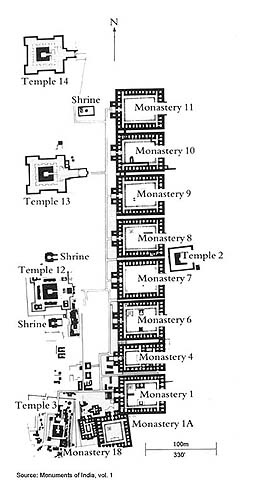
Nalanda
Pala period, 7th - 12th century
Bihar, near Patna
The ancient Buddhist university of Nalanda was probably founded in the Gupta period (6th century). Prominent remains include nine monasteries and four temples, dating mostly from the 7th century AD but with some earlier and later elements, that face each other in two rows. A Hindu temple of the same period, designated Temple 2 in the plan, abuts the rear wall (east) of monasteries 7 and 8. Its association with the Buddhist university of Nalanda is unclear.
Buddha and Mahavira both used to visit Nalanda during their lifetimes, and Ashoka Maurya worshiped at a Buddhist shrine there in the 3d century BC. By the 7th century AD, it was the most famous center of Buddhist learning in Asia, mentioned by eminent travelers like Xuanzang (Hsüan-tsang) and Izing (I-tsing), and receiving visitors from all over the Buddhist world. An important center of art production as well as learning, Nalanda's preeminence continued until it was sacked by Muslim invaders in the late 12th century.

